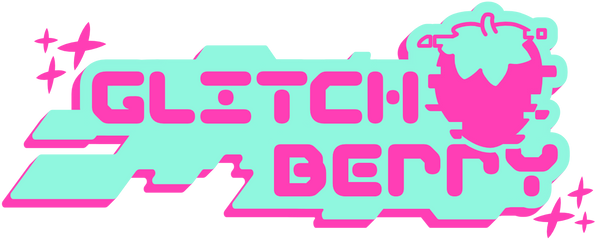
Sustainable Practices at GlitchBerry: Staying Environmentally Conscious while Packing and Shipping Products
Share
Whenever and wherever possible here at GlitchBerry, I strive to minimize my environmental impact when it comes to creating, packing, and shipping my products. From carbon-neutral shipping to utilizing recyclable materials and implementing creative packaging solutions, GlitchBerry strives to do as much as possible to reduce our ecological footprint. While GlitchBerry is a small independently-owned brand and has a much smaller footprint than a large corporation, I still want to be as considerate as possible to the planet we live on. Let’s take a look at some of the ways I keep GlitchBerry as sustainable as possible.
-
Minimizing Ink Usage and Ink Refills: More than 375 million empty ink and toner cartridges are thrown out every year, and not only does that contribute to plastic waste, but also lets chemicals from the ink that may harm the environment seep into landfills. A thermal printer uses no ink, and can be used for anything from shipping labels (what I primarily use it for), to product packaging, thank you stickers, “Fragile: do not bend” stickers, or whatever else you can think of.
In order to cut down on plastic waste, I also use ink refills to cut down on the waste my inkjet printer produces. In the past when my printer ran out of ink, I would recycle my ink cartridges and buy new ones, but now I can extend the life of the cartridge (and thus the plastic and microchips it's made of) by reusing it and cutting down on consumption overall. -
Recycling and Reusing Packaging Materials: Any product-based business is going to generate some amount of waste in the form of packing and shipping materials. At GlitchBerry, I try to cut down on as much of that waste as possible by reusing materials. Empty boxes and bubble wrap received from shipments are carefully collected and repurposed for outgoing orders or other shipments. I also, when possible, reuse materials such as the clear plastic bags my products arrive in. This practice not only reduces waste but also conserves energy and resources that would otherwise be required to produce new packaging materials.
-
Opting for Recyclable and Compostable Materials: GlitchBerry prioritizes the use of recyclable and compostable materials in its packaging. Paper bags, paper envelopes, and cardboard boxes are chosen for their recyclability, allowing customers to easily dispose of them in an eco-friendly manner. Compostable cello bags made of plant fiber and compostable bubble mailers provide a sustainable alternative to traditional plastic packaging, further reducing the environmental impact. All of my materials are clearly labeled, so you know whether something is recyclable or compostable.
-
Water-Activated Paper Tape: Typical plastic packing tape is made of polypropylene, which can’t recyclable or biodegradable. Instead, I use water-activated paper tape instead of traditional plastic tape. This eco-friendly tape is made from recyclable materials and is easily biodegradable.
-
Creative Void Fill Solutions: One of the small things I do here at GlitchBerry is reuse my label backing paper. My shipping labels come special from EcoEnclose, with a unique recyclable backing paper. In order to give it a second life before it hits the recycling bin, I shred it and turn it into void fill for boxes, which keeps my products safe in transit. While the shredded label paper must still be recycled by the customer, I reduce packaging waste reusing these label backings instead of contributing to more consumption by purchasing additional crinkle paper or plastic fillers.
-
Carbon-Neutral Deliveries: GlitchBerry is committed to reducing its carbon footprint during the shipping process. Shopify, which we use for our storefront, has introduced an app called Planet, which automatically tracks shipping emissions and offsets them for a small fee (paid by us, not the customer). We use the highest tier, “Millennium,” which also invests in carbon offset initiatives to remove carbon from the atmosphere. Carbon offsetting is often critiqued for being greenwashed, or for being marketed as more environmentally conscious than it actually is. But since we need to send your orders to you one way or the other, we’d like opt-in to programs that may help keep our shipping sustainable rather than do nothing at all. You can learn more about our carbon-neutral shipping initiatives on our Climate Commitment page.
-
Made-to-Order Items Reduce Excess Waste: Textile waste contributes to an estimated 7% of total waste in landfills, and with an estimated 80-100 billion new garments created per year, the fashion industry creates a monumental environmental impact. Most of GlitchBerry’s apparel items, as well as some accessories, are manufactured using a made-to-order production model, which helps minimize excess waste. Rather than mass-producing items and risking overstock, products are created only when an order is placed. This approach ensures that each item is thoughtfully crafted, reducing the likelihood of unsold inventory and unnecessary waste. By choosing made-to-order items, customers not only receive unique, freshly made products but also contribute to the reduction of environmental impact associated with excess production.
At GlitchBerry, we embrace the dreams of yesterday’s future, and that includes the dream of a living and livable planet. Together, we can embrace a kawaii retrowave lifestyle with a shared commitment to preserving the planet for generations to come.
@madameberry A lot of this stuff came from amazon but I've since heard of ecoenclose so when what I have runs out, I know where to get more sustainable items. #smallbusinesstiktok #sustainablepackaging ♬ original sound - MadameBerry
Featured image Photo by Zsófia Fehér: https://www.pexels.com/photo/heart-shaped-neon-decoration-15595273/
